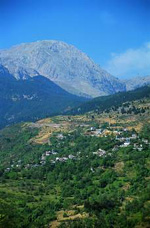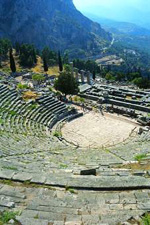The monument stands opposite the historical hill of Kolonos and represents Leonidas in full armour. It was designed by B. Phalereus, and was erected in the 1950s at the expense of Greeks living in America.
The monument was built to commemorate the battle at Thermopylae, and is located at the centre of the pass, where the final phase of the battle took place, as is attested by the accumulation at the foot of the hill of iron and bronze spearheads dated to the 5th century B.C. Members of the Amphiktyony erected on the hill a stone statue of a lion in memory of the deceased warriors, with an epigram written by Simonides, but the monument is not preserved today.
A restricted excavation on the hill of Kolonos, in 1939, revealed fortification works of several periods, Roman and Byzantine graves, and ruins of Byzantine buildings.
Archaeological Museum of Lamia
The archaeological Museum of Lamia is housed in the first floor of a renovated, two - storied building on the summit of the hill northeast of modern Lamia. It was erected by the first king of Greece after the War of Independence, Otto, (1830's). It served as barracks until World War II. In 1973 the Ministry for Defence conceded its rights over both the castle and the ruined barracks the Ministry of Culture. In 1984 the Municipality of Lamia undertook the repairs. In 1991 the offices of the 14th Ephorate for Prehistoric and Classical Antiquities were moved to the southern half of the ground floor. The Museum was inaugurated in September 1994. Since the structure has been characterized preservable, it is not possible to add extra rooms.
Gravia : A historic village with a population of about 1,050 inhabitants which probably took its name pidginly from the neighbouring ancient town of Karphia. It is the capital of the new Municipality a nd it is situated on the 33rd km of Amfissa-Lamia National Road. Gravia is famous for the historc battle given on 8th Mai 1821 by Androutsos and the other leaders of the struggle, who closed themselves in the legendary-historic Inn along with the 120 fighters and other supporters in the region and stopped Omer Vrionis, by cutting his way towards Salona and Peloponnese, targetting to the suppression of the Revolution. On the site dominates the statue of hero Odysseas and, reently, the historic Inn ("Hani") has been restored (It was inaugurated by the President of Hellenic Republic, M. K. Stefanopoulos and it is open to visitors). In a distance of 5 km to the South East, on the mountainsides there is the monastery of the Assumption of Virgin Mary (or Panasari), a significant monument, with a Byzantine church (with two domes), built in AD 1517.
nd it is situated on the 33rd km of Amfissa-Lamia National Road. Gravia is famous for the historc battle given on 8th Mai 1821 by Androutsos and the other leaders of the struggle, who closed themselves in the legendary-historic Inn along with the 120 fighters and other supporters in the region and stopped Omer Vrionis, by cutting his way towards Salona and Peloponnese, targetting to the suppression of the Revolution. On the site dominates the statue of hero Odysseas and, reently, the historic Inn ("Hani") has been restored (It was inaugurated by the President of Hellenic Republic, M. K. Stefanopoulos and it is open to visitors). In a distance of 5 km to the South East, on the mountainsides there is the monastery of the Assumption of Virgin Mary (or Panasari), a significant monument, with a Byzantine church (with two domes), built in AD 1517.
The Municipality of Gravia is formed by: Kastellia , a village to the west of Gravia at an altitude of 500m, constructed during the Frankish Domination by the ruler Vonfatios. It owes its name to the castle whose ruins are still visible above the village. There are also the ruins of the ancient town of Erineus in the area of Agios Vasileios. After a few kilometres heading up in the direction of Giona, we meet Chani Zagana , a location of great natural beauty with a fir forest, shady plane trees and limpid waters. The surrounding area of some 24,000 hectares up to Athanasios Diakos and Pyra has been designated a "controlled hunting region " for which hunters from all over Greece and abroad can obtain a special permit and under the supervision of the Forest Inspectorate hunt various game such as pheasant, partridge, hare, deer and wild boar. Apostolia (Kato Kaniani), a small village at the foot of Mt Oitis, north-west of Gravia at an altitude of 520m. Mariolata , situated east of Gravia at an altitude of 380m, which has wide vistas and picturesque locations. On the nearby hill are the remains of the Doric town of Boeon. K a l o s k o p i (Koukouvista), an attractive tourist location to the north of Giona at a height of 1,040m. It offers magnificent views, abundant spring water, a healthy climate and beautiful locations. It is the perfect place for a summer holiday. It was also the birthplace of the brave hero of the War of Independence, Papa- Andrea Mori.
Oinochori (Pano Kaniani), a small village nestling amidst the oak trees on the sides of Mt Oitis, at a height of 900m, with natural beauty and cool springs (Kefalovrysi and Katero, with the cool plane trees). Outside the village are the ruins of the Doric town of Dryopes. In Oinochori rooms are being built . Sklythro , a small village built at an altitude of 800m on the side of Mt Oitis, surrounded by oak trees. Vargiani , a small village to the south of Gravia, built on the side of Mt Parnassos at a height of 900m. It became famous as a result of a battle won by the Greeks in the War of Independence on 24th September 1824 and was the birthplace of the chieftain Captain Liapis, whose daughter, Despo, was wooed by King Otho (Liapis was his highest-ranking officer) and almost became queen. Today, Vargiani is a traditional hamlet of elegant stone houses, many of which have been bought and restored by summer visitors.
 Phocis has a good touristic substructure and it offers a pleasant stay all year round. The visitor can marvel at the grandeur of the Ancient Stadium of Delphi where the ΄΄Pythian Games΄΄ were held every 4 years as well as the Temple of Apollo, the theatre, the Spring Castallia, the temple of Vestibular Athena. In the new town of Delphi one can admire the European Cultural Centre of Delphi in addition to the house of Aggelos and Eva Sicelianos which has been converted into a Museum of Delphic Celebrations.
Phocis has a good touristic substructure and it offers a pleasant stay all year round. The visitor can marvel at the grandeur of the Ancient Stadium of Delphi where the ΄΄Pythian Games΄΄ were held every 4 years as well as the Temple of Apollo, the theatre, the Spring Castallia, the temple of Vestibular Athena. In the new town of Delphi one can admire the European Cultural Centre of Delphi in addition to the house of Aggelos and Eva Sicelianos which has been converted into a Museum of Delphic Celebrations.
From Delphi the visitor can easily go over to the monastery of Elias the Prophet via the road which leads to Chrysso, where he will be impressed by the bewitching site on which the exquisite wood-carved choir-screen with depictions of the Old and the New Testament is built. On moving on, one can visit Amfissa where he can see the Metropolitan Church of Evangelist Virgin Mary, the castle of Salona (Orgia), the Citadel of Amfissa with remains of all structural orders, the Church of the Saviour as well as other sights.
 As one continues driving towards the coast it is well worth visiting the beautiful town of Itea which is the sea port of Amfissa and Delphi. Kirra also belongs to the Municipality of Itea. From excavations that have taken place, the existence of a settlement dating back to 3000 B.C. is acknowledged. Further up in Desfina and the surrounding area the visitor is able to admire the Monastery of St. John the Baptist, the Shrine of Archangels (in the precinct of St. Haralabos). On taking the coastal road to Nafpactos, the visitor can meet the magnificent historic Galaxidi, where he can admire the Church of St. Nicholas, the Nautical and Ethnological Museum, the Folklore museum, the church of St. Paraskevi with its sundial, the Byzantine monastery of the Saviour built in 1250 A.D., the great history researcher K. Sathas’ house, the Girls School, Xirolaka, the old 15th century stone aqueduct, the Aggelis building (currently Folklore museum), the Bourzeiko building and other sights.
As one continues driving towards the coast it is well worth visiting the beautiful town of Itea which is the sea port of Amfissa and Delphi. Kirra also belongs to the Municipality of Itea. From excavations that have taken place, the existence of a settlement dating back to 3000 B.C. is acknowledged. Further up in Desfina and the surrounding area the visitor is able to admire the Monastery of St. John the Baptist, the Shrine of Archangels (in the precinct of St. Haralabos). On taking the coastal road to Nafpactos, the visitor can meet the magnificent historic Galaxidi, where he can admire the Church of St. Nicholas, the Nautical and Ethnological Museum, the Folklore museum, the church of St. Paraskevi with its sundial, the Byzantine monastery of the Saviour built in 1250 A.D., the great history researcher K. Sathas’ house, the Girls School, Xirolaka, the old 15th century stone aqueduct, the Aggelis building (currently Folklore museum), the Bourzeiko building and other sights.
 At Efpalio the visitor will admire the Holy Monastery of the Virgin Mary of Varnakova, the Historic Monastery of St. John of Thermes, the Old Christian church of the Ascension of the Saviour, the wonderful Catholic of unique Art Byzantine technique, the newly-established Monasteries of Trikorfo, Kefalogiofiro and the Folklore museum.
At Efpalio the visitor will admire the Holy Monastery of the Virgin Mary of Varnakova, the Historic Monastery of St. John of Thermes, the Old Christian church of the Ascension of the Saviour, the wonderful Catholic of unique Art Byzantine technique, the newly-established Monasteries of Trikorfo, Kefalogiofiro and the Folklore museum.
In the Municipality of Vardousia one can come across the historic Monastery of St. John the Baptist where Athanasios Diakos took monastic vows, the bust of the hero of Alamana, captain Andritsos’ house, in addition to the Folklore museum.
In the Municipality of Gravia the bust of Ulysses the hero towers above the place and the historic inn has been recently restored. It is worth visiting the Assumption of the Virgin (or Panasari), a remarkable monument with a Byzantine order church.


